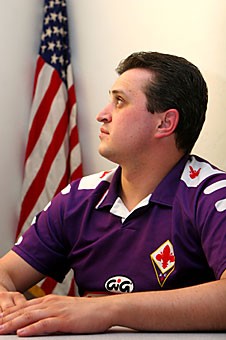A UA alumnus’ goal of having a U.S. flag in every classroom at the UA came closer to becoming a reality with the state senate’s approval Thursday of a bill that would require flags in Arizona’s public classrooms.
“”It passed with overwhelming senate support,”” said Tyler Mott, a UA alumnus. “”It’s very pleasing to me that this is happening.””
Mott proposed the idea of putting a flag in every UA classroom to administration officials in 2004 while he was a UA student.
He decided to try to make the idea happen at the UA after reading an article about a group of university students in Florida who were able to get their school to adopt the policy, Mott said.
Although UA administration officials thought his idea was noble, they decided not to pursue the plan due to the possible costs involved with the idea, such as vandalism of the flags, Mott said.
“”It didn’t deter me. I still wanted to get it done,”” Mott said.
Mott took his idea to the Arizona Board of Regents and state Legislature until state representative Russell Pearce decided to write the bill last year.
The bill, HB 2583, will require a 2-by-3 foot U.S.-made flag to be mounted in every classroom at the UA by July 1, 2007.
The intent of the bill is to promote patriotism among Arizona’s students, Mott said.
“”The flag is a great tool for teaching students about our freedoms,”” said Mott.
Tamara Begay, a junior from Shadow Mountain High School, said she also believes placing flags in the Arizona state universities will promote patriotism.
“”It’s more of a supporting thing. Especially for our troops overseas,”” Begay said.
Others disagreed that the bill would promote patriotism.
Visiting scholar Regmi Dhanangay said if the state wants to promote patriotism, a class or video about patriotism would do a better job than hanging a flag in the classroom.
“”A flag has nothing to do with that,”” Dhanangay said.
“”I don’t think that international students should be subjected to having American culture forced upon them,”” said Ashley Lovez, a molecular and cellular biology junior.
Lovez said she doesn’t think placing a flag in university classrooms would have any effect on students.
“”Once you are eighteen you have the right to decide how you feel about politics,”” Lovez said.
Gilbert Maldonado, and architecture junior and international student from Mexico, said he doesn’t think international students would mind the having the U.S. flags in the classrooms, but he doesn’t think it would promote patriotism.
The bill allows the schools to obtain the flags and mounting hardware through donations, but the schools must pay for their own flags and installation if donations aren’t received by July 1, 2007.
Al Tarcola, director of facilities management, said the UA has over 400 classrooms that will require flags.
Tarcola said he estimates the flags and their installation will cost about $20 each.
Charlie Smith, owner of Tucson Map and Flag Company, said a standard 2-by-3 foot flag sells for about $20.
Smith said he has already been contacted by some local schools for flag prices and by individuals and organizations interested in purchasing flags to donate to schools.
Even though the danger of vandalism and theft of the flags is a concern, the UA would comply with the bill if it becomes law, said Greg Fahey, associate vice president for government relations.
Although a final version of the bill will still need approval from the Legislature and ultimately receive approval from Gov. Janet Napolitano, the bill is expected to be signed into law, Fahey said.









